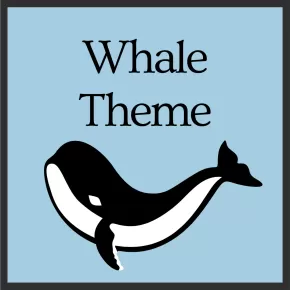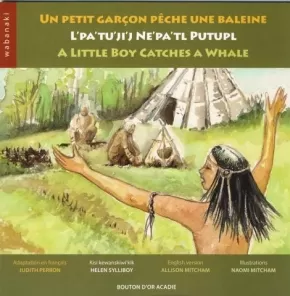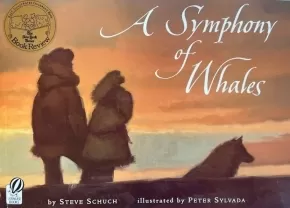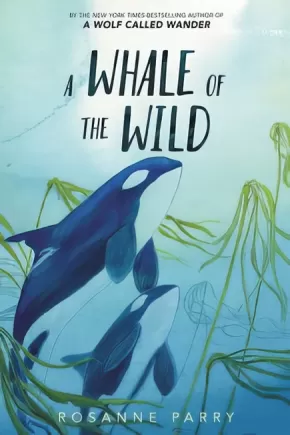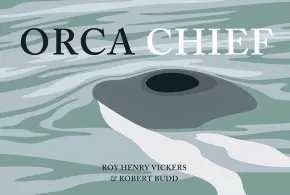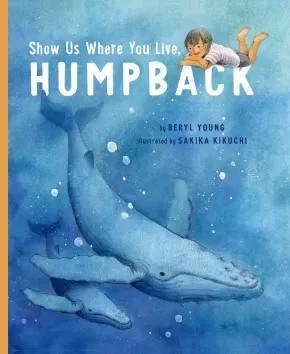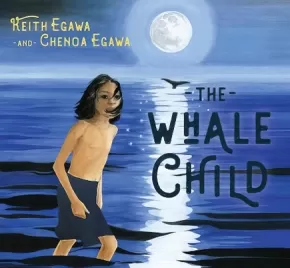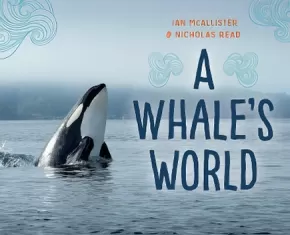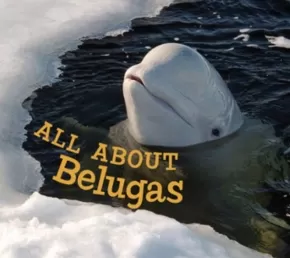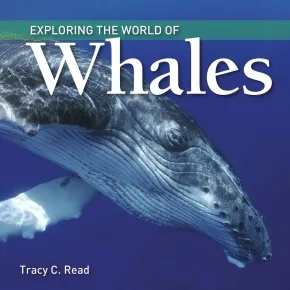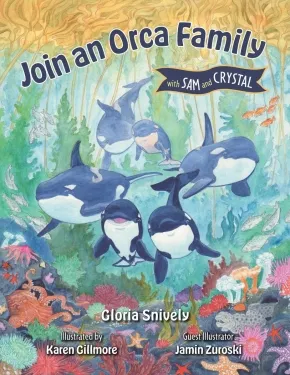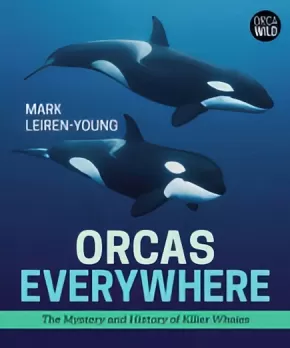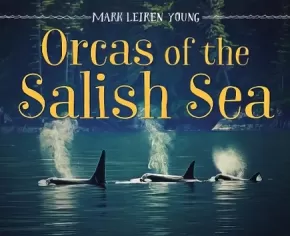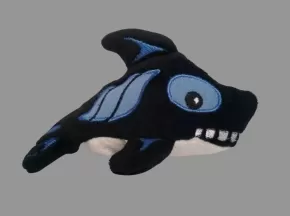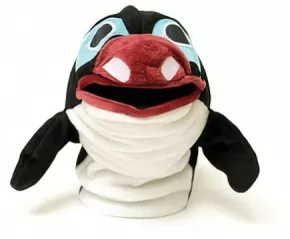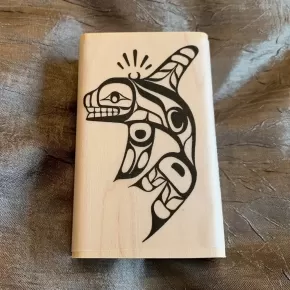
Theme Bundle: Whales
$316.88
Text Content Territories:
Indigenous Canadian;
Status: Available
Details:
This bundle for elementary students includes resources for learning about whales. It includes works of fiction and nonfiction, as well as learning environment resources, such as puppets.
Scroll below to learn more about the Indigenous and supplementary resources included in this bundle. Resource availability may fluctuate.
● The listed materials for this bundle
can be purchased as a full bundle or separately. To purchase the full bundle click on the "Add to
Basket" button above (the first one on this page).
● To purchase items individually, click the "Add to Basket" buttons below, beneath the individual
item titles.
Fiction
A Little Boy Catches a Whale
$7.95
Format:
Paperback
Text Content Territories:
Indigenous Canadian; First Nations; Mi'kmaq;
Grade Levels: 3;
ISBN / Barcode: 9782922203493
Synopsis:
Synopsis:
One late fall day, the boy told the old people that he was going fishing. When he returned home, he said that he had caught a whale.
Un matin, juste avant l’arrivée de l’hiver, le garçon dit à ses parents qu’il part à la pêche. Peu de temps après, il revient chez lui, tout heureux d’annoncer qu’il a pêché une baleine.
Educator & Series Information
This book is delivered in a triple-language format of English, French, and Mi'kmaq.
This book is part of Collection Wabanaki.
A Symphony Of Whales (4 in Stock) - ON SALE
$7.50 $12.50
Artists:
Format:
Paperback
Text Content Territories:
Indigenous Siberian;
ISBN / Barcode: 9780152165482
Synopsis:
Synopsis:
Once, humans and whales made music together . . . but that was long ago.
Glashka is the only one in her village who can hear the voice of Narna, the whale. That gift leads her to great responsibility one day, when she discovers thousands of whales trapped in an inlet. The narrow route to the sea is rapidly icing over, and every day ice covers more of the open water the whales need to breathe. There seems to be no way out. . . . This story, based on an actual event, tells of a dramatic rescue--a tale of bravery and faith and the power of music.
Reviews
"During the winter of 1984-1985, nearly 3,000 beluga whales were trapped in the Senyavina Strait of Siberia--and saved by the bravery and persistence of villagers and the crew of a passing icebreaker. Schuch, a musician, turns this episode into a picture book by casting a child as heroine. Glashka has always been able to hear music in her head, and the ""old ones"" of the village tell her she hears ""the voice of Narna, the whale. Long has she been a friend to our people."" Glashka uses this talent to find the trapped whales and then to discover the secret of saving them. The plotting and diction are a little trumped-up, but on balance the text is tender and moving, and debut illustrator Sylvada's heavy oil paintings readily transport readers to the bitter winter days of Siberia. Emphasizing the changing light and the textures of characters' clothing instead of individual expressions, the illustrations cast a mood that reinforces the sober issues of the text." - Publisher's Weekly
Educator Information
Recommended Ages: 4-7.
Additional Information
32 pages | 11.00" x 8.00"
A Whale of the Wild
$21.99
Format:
Hardcover
ISBN / Barcode: 9780062995926
Synopsis:
Synopsis:
In this book, a young orca whale must lead her brother on a tumultuous journey to be reunited with their pod. This gorgeously illustrated animal adventure novel explores family bonds, survival, global warming, and a changing seascape. Includes information about orcas and their habitats.
For Vega and her family, salmon is life. And Vega is learning to be a salmon finder, preparing for the day when she will be her family’s matriarch. But then she and her brother Deneb are separated from their pod when a devastating earthquake and tsunami render the seascape unrecognizable. Vega must use every skill she has to lead her brother back to their family. The young orcas face a shark attack, hunger, the deep ocean, and polluted waters on their journey. Will Vega become the leader she’s destined to be?
A Whale of the Wild weaves a heart-stopping tale of survival with impeccable research on a delicate ecosystem and threats to marine life. New York Times-bestselling author Rosanne Parry’s fluid writing and Lindsay Moore’s stunning artwork bring the Salish Sea and its inhabitants to vivid life.
An excellent read-aloud and read-alone.
Includes black-and-white illustrations throughout, a map, and extensive backmatter about orcas and their habitats.
Reviews
“Parry creates a spellbinding, heart-stopping adventure for middle-grade readers—this time about a pod of orca whales and their plight in today’s Salish Sea. . . . Parry’s thorough research, observation, and creative writing combine to share the marvelous matriarchal familial world of orcas . . . Her descriptive narrative rises in intensity to match each new danger and resolves with a bittersweet yet hopeful finish. . . . Excellent.” — Booklist (starred review)
“After a tsunami devastates their habitat in the Salish Sea, a young orca and her brother embark on a remarkable adventure. . . . Vega and Deneb tell their harrowing story, engaging young readers while educating them about the marine ecosystem. . . . A dramatic, educational, authentic whale of a tale.” — Kirkus Reviews
"Vega is a young orca whale being trained by her mother to one day be the group’s Wayfinder . . . But when she and her young brother are separated from the pod . . . Vega must use her wayfinding skills to reunite them with their elders. . . . Parry weav[es] a great deal of information about orcas and their habits into the narrative.” — School Library Journal
Educator Information
Recommended for ages 8 to 12.
Additional Information
336 pages | 5.50" x 8.25"
Grandfather Bowhead, Tell Me a Story
$17.95
Artists:
Format:
Hardcover
Grade Levels: Preschool;
ISBN / Barcode: 9781772272970
Synopsis:
Synopsis:
Richly illustrated and lovingly told, this book is a warm and inviting read, perfect for sharing with any little one. Bowhead whales are the longest-living mammals on the planet, living over 200 years. In this heartwarming story, a grandfather bowhead recounts to his young grandchild calf all the beautiful, amazing, and surprising things he has seen in his lifetime, all while assuring the little calf that there is nothing more wondrous than the love a grandfather has for his grandchild.
Reviews
"Together with painterly illustrations in monochromatic blues of the ocean, this underwater tale shows the wondrous love of a grandparent for his grandchild...Tender words of affection are perfect for sharing with any young child or grandchild."—Kirkus
"The expansive illustrations, awash in marine blues and greens, capture the drama and majesty of the Arctic while also showcasing the tender relationship between the whales. A lovely choice for preschool storytimes."—Booklist
Educator Information
Recommended for ages 0 to 3.
Includes an Inuktitut pronunciation guide and fun facts about bowhead whales.
Themes: Indigenous, baby whale, bedtime book, Arctic, Iqaluit
Additional Information
28 pages | 9.50" x 9.50" | Hardcover
Orca Chief
$19.95
Format:
Hardcover
Text Content Territories:
Indigenous Canadian; First Nations; Tsimshian (Ts'msysen);
ISBN / Barcode: 9781550176933
Synopsis:
Synopsis:
Thousands of years ago in the village of Kitkatla, four hunters leave home in the spring to harvest seaweed and sockeye. When they arrive at their fishing grounds, exhaustion makes them lazy and they throw their anchor overboard without care for the damage it might do to marine life or the sea floor.
When Orca Chief discovers what the hunters have done, he sends his most powerful orca warriors to bring the men and their boat to his house. The men beg forgiveness for their ignorance and lack of respect, and Orca Chief compassionately sends them out with his pod to show them how to sustainably harvest the ocean’s resources.
Accompanied by almost exclusively new illustrations by Roy Henry Vickers, this next installment of the Northwest Coast Legends will captivate readers young and old with its vivid imagery and remarkable storytelling.
Educator & Series Information
Orca Chief is the third in a series of Northwest Coast legends by Roy Henry Vickers and Robert Budd.
Other books in this series include:
Raven Brings the Light
Cloudwalker
Orca Chief
Peace Dancer
Recommended for ages 3 to 6.
Additional Information
40 pages | 12.00" x 8.25"
Show Us Where You Live, Humpback
$22.95
Artists:
Format:
Hardcover
ISBN / Barcode: 9781771645737
Synopsis:
Synopsis:
This evocative picture book celebrates a child’s connection and kinship with whales.
Swimming, singing, and blowing bubbles—children and baby whales love many of the same things! This lyrical picture book compares the parent-child relationship with the bond between a mother humpback whale and her calf, showing how their underwater lives are touchingly like our own. Patterned in a call-and-response format, where the mother observes and the child responds, this book is peppered with facts and begs to be read aloud before bedtime. At the story’s end, acclaimed author Beryl Young and debut illustrator Sakika Kikuchi leave readers gently falling asleep, dreaming of the wonderful world we share with whales.
Educator Information
Recommended for ages 3 to 7.
Explores how we are similar to humpback whales in a charming and thoughtful way that helps children better understand the natural world and their place in it.
Encourages connection to the natural world. Facts about Humpback whales are woven throughout the text.
Supports curriculum related to ecosystems and webs of life for grades 2-3
Guided Reading Level: M
Common Core State Standards
RL.2.1,2,3,4,5,6,7,9
W.2.1,2,3,5,6,8
SL.2.1,1a,1b,1c,2,3,4,5,6
L.2.1,1a,1b,1c,1d,1e,2,2a,2b,2c,2d,2e,3,4,4a,4b,4c,4d,4e,5,5a,5b,6
Next Generation Science Standards
2-LS4.D: Biodiversity and Humans
Additional Information
40 pages | 9.00" x 11.00"
The Whale Child
$25.95
Format:
Paperback
Text Content Territories:
Indigenous American; Native American; Salish; Coast Salish;
ISBN / Barcode: 9781623174866
Synopsis:
Synopsis:
An inspiring children's book that introduces young readers to the environmental challenges facing the planet through the eyes of Coast Salish characters and authors
"You have family on land as you do in the sea. . . being a caretaker of the earth begins with taking care of the water that all life depends on."
Shiny is a whale child. One day his mother teaches him about the harm facing the world's oceans because of human carelessness. Shiny agrees to be turned into a boy by the ocean's water spirit so he can visit the land and alert people to these dangers. He meets Alex, a young Coast Salish girl who learns from Shiny that the living spirit of water exists in everything--glaciers, rivers, oceans, rain, plants, and all living creatures. Together the two travel the earth, confronting the realities of a planet threatened by an uncertain future. Inspired by Shiny's hope, humor, and wisdom, Alex makes the promise to become a teacher for future generations. She realizes that the timeless Indigenous value of environmental stewardship is needed now more than ever and that we must all stand up on behalf of Mother Earth.
Written and illustrated by Indigenous authors Keith Egawa and Chenoa Egawa, The Whale Child introduces children ages 7 to 12 to existing environmental issues with a message of hope, education, sharing, and action. Also included are resources for students and teachers to facilitate learning about Pacific Northwest Indigenous cultures and the environment.
Reviews
"Vivid illustrations juxtapose the beauty and scale of the natural world that the children explore. . . . This necessary read decolonizes the Western construction of climate change." —Kirkus Reviews (starred review)
"The sacred art of Indigenous storytelling is beautifully upheld in The Whale Child. It teaches us of our relationship with the living Earth, about balance and respect and the responsibilities that we hold toward one another across species. The story guides the reader using traditional Coast Salish lore in a contemporary narrative, masterfully weaving the timeless wisdom of Indigenous ways of knowing into our current reality. The whale child's journey is taken for us all. We must bear witness.” —Sherri Mitchell Weh’na Ha’mu Kwasset, author of Sacred Instructions
“Those of us with hands and feet (alas) who self-identify as members of the Earth’s Whale Tribe now have a new wonderful, strong, kind, and happy tale to represent us, and with which to remember our connection to All Things by. The Whale Child provides that ‘smart step in the right direction’ we all need.”—Paul Owen Lewis, author and illustrator of Storm Boy and Frog Girl
“The Whale Child is an environmental fable for our time. This is the story of Alex, daughter of a mixed Coast Salish and Polynesian family and Shiny, a whale turned briefly human to impart the wisdom of the ocean to humanity. The book is at turns educational, poignant, warm, sad, and funny. Chenoa and Keith Egawa’s delicate watercolor illustrations evoke the chill water, crisp air, and glowing sunshine of the beautiful Salish Sea. . . . The Whale Child is an important book for children, parents, and teachers to read and ponder.” —Bryn Barnard, author of The New Ocean
“A long time ago, we didn’t have to be taught that everything has a spirit, a life force, a memory, a moment that all things came into existence. . . . Brother and sister Keith and Chenoa Egawa bring us back to those teachings in their story The Whale Child. . . . We learn how to quiet our minds to hear the message that mother earth holds the cure, the answers, and the way to heal her if we just take a moment to reconnect and hear what she has to say.”—Janine Gibbons, Haida artist and children's book illustrator for Baby Raven Reads series, Sealaska Heritage Institute
“For the Coast Salish people, the nonhuman living world is not filled with resources to be abused and extracted—rather, these are our relatives that carry our original instructions. . . . Promoting these concepts and the necessary fusion of Indigenous ecological perspectives with western understandings is the fully realized mantra narrated for us in this marvelous story. The critical insights of our responsibilities and the truth of reciprocity—particularly with water, the first medicine—are woven into each page. Through playful adventure, the essence of ancient instructions emerges in the context of a modern world.”—Valerie Segrest, Muckleshoot, author, Native food systems strategist and wild medicine expert
Educator Information
Recommended for ages 7 to 10.
Includes colour illustrations. Beginner's chapter book.
"The story is followed by extensive backmatter: a glossary of environmental terms, a brief history of the Pacific Northwest Native cultures, classroom learning activities, and ideas for student projects. Infusing qualities of traditional storytelling into the narrative, Keith Egawa (Lummi) and Chenoa Egawa (Lummi and S’Klallam) offer a perspective on climate change from the lens of Indigenous people. By relating the tale through the eyes of children, the author-illustrator team evokes an empathy that should stir a wide audience." - Kirkus Reviews
Additional Information
136 pages | 7.00" x 6.49"
Non-Fiction
A Whale's World
$19.95
Artists:
Format:
Hardcover
ISBN / Barcode: 9781459812734
Synopsis:
Synopsis:
A Whale’s World follows a pod of spy-hopping orcas as they explore the ecosystems of the Great Bear Sea while hunting for their next meal. Past rocky shores and through kelp forests, they observe foraging wolves, hungry grizzly bears, curious black bears, graceful fin whales, splashing porpoises, slippery seals and other members of the Pacific coastal food web. The book gives readers a fun introduction to the many ways that marine and land animals interact with their environments and with each other.
Educator & Series Information
This is the fourth book in the My Great Bear Rainforest Series.
Books in this series include:
Wolf Island
A Bear's Life
The Seal Garden
A Whale's World
Recommended Ages: 5-8
Additional Information
32 pages | 10.75" x 8.75" | Hardcover (HC)
All About Belugas - Nunavummi Reading Series
$8.95
Format:
Paperback
ISBN / Barcode: 9781774504604
Synopsis:
Synopsis:
Belugas are one of the many amazing animals found in Nunavut! Learn all about what belugas look like, where they live, what they eat, how they communicate, and where they migrate. This non-fiction book gives information and facts about belugas alongside beautiful photographs and illustrations.
Educator & Series Information
Recommended for ages 6 to 8.
This book is part of the Nunavummi Reading Series, a Nunavut-developed series that supports literacy learning while teaching readers about the people, traditions, and environment of the Canadian Arctic. It is a Level 8-11 book in the series.
Nunavummi Reading Series books have also been officially levelled using the Fountas & Pinnell Text Level Gradient™ Levelling System. This book's F&P Level is L.
Additional Information
24 pages | 8.00" x 8.00" | Paperback | Colour photographs throughout
Animals Illustrated: Bowhead Whale
$15.95
Artists:
Format:
Hardcover
Text Content Territories:
Indigenous Canadian; Inuit;
ISBN / Barcode: 9781772271621
Synopsis:
Synopsis:
In this book, kids will learn how bowheads raise their babies, where they live, what they eat, and other interesting information, like how they can eat when they don’t have any teeth!
Reviews
"The book is divided into sections covering such topics as: range, skeleton, blowholes, baleen, diet, reproduction, predators, fun facts, and traditional uses. There are typically two short paragraphs per heading, with plenty of detailed diagrams and illustrations.... That the author seemingly anticipates the questions young readers may pose results in an engaging relay of facts. References to Inuit culture are peppered throughout." - CM Magazine
Educator & Series Information
This book is part of the non-fiction Animals Illustrated series, which mixes fun-filled animal facts suitable for the youngest of readers with intricately detailed illustrations to create a unique and beautiful collection of children’s non-fiction books on Arctic animals. Each volume contains firsthand accounts from authors who live in the Arctic, along with interesting facts on the behaviours and biology of each animal.
Recommended Ages: 5-7
Available in French: Baleine boreale
Additional Information
28 pages | 6.75" x 9.25"
Exploring the World of Whales
$6.95
Format:
Paperback
ISBN / Barcode: 9781770859494
Synopsis:
Synopsis:
With sturdy, streamlined bodies, outfitted with insulating blubber, flippers, tail flukes and fins, whales -- all known as cetaceans -- are built for life in the water. In Exploring the World of Whales, we meet the baleen whales and the largest members of the toothed whales, including the killer whale, the biggest of the dolphins. These marine mammals range in size from the 108-foot-long (33 m) blue whale to the barely 9-foot-long (2.7 m) dwarf sperm whale while boasting a range of distinctive physical traits, including the sperm whale's gigantic head, the humpback's barnacle-covered body and outsized flippers, and the narwhal's eight-foot-long tusk.
Young readers will learn the difference between the baleen and toothed whales and how these differences affect habitat, diet and behaviors. They'll discover how whales communicate with one another across vast stretches of ocean, how some cooperate to raise families and hunt their prey, and how some are capable of remarkable feats of migration and deep diving. A lively, fully illustrated introduction to some of the planet's most intelligent species, this book also addresses the ongoing risks to whale populations.
Reviews
"Crisp photographs accompany interesting text that provides fascinating information about both baleen and toothed whales of many varieties. There's information here about diet, habitat, communication, behavior, and social interactions." — Teresa Bateman, Puget Sound Council for the Review of Children's and Young Adult Literature, August 2018
Educator & Series Information
Recommended for ages 7 to 12.
The Exploring the World of... nature series was created for young readers who are eager to learn more about the wild creatures of the world. Each title contains beautiful photographs of the animals in their natural habitats and the highly readable text explores their daily lives and physical characteristics, how they make their homes, how they raise their young and what they eat.
Additional Information
24 pages | 8.00" x 8.00" | full color throughout, index | Paperback
Join an Orca Family with Sam and Crystal
$29.95
Artists:
Format:
Hardcover
Text Content Territories:
Indigenous Canadian;
ISBN / Barcode: 9781038305527
Synopsis:
Synopsis:
Sam has always dreamed about being an orca, while Crystal discovers she hopes to grow up and study orcas as a marine biologist. When the siblings head to the Pacific coast to visit their aunt and uncle, they are in for a treat! Aunt Kate is a marine biologist, and she has all kinds of interesting facts to share about the Resident orca pods.
Sam and Crystal learn about the different populations of orcas and their food sources, attend the Save the Salish Sea Festival with an Indigenous woman, and have their own incredible adventure with an orca pod. They come away with a new understanding about the role they play in protecting our animal friends and what it will take to ensure that the orca pods have their own vibrant, beautiful future.
Join an Orca Family with Sam and Crystal is the fourth book in the Sam and Crystal series. It weaves a wealth of factual information about the orcas of the Pacific Northwest Coast with an entertaining story and beautiful, whimsical, biologically accurate illustrations. Children will learn basic ecology concepts while exploring the Pacific coastline right alongside Sam and Crystal.
Educator & Series Information
Recommended for ages 11 and under.
This book is part of the Explore with Sam and Crystal Series.
Additional Information
64 pages | 8.50" x 11.00" | Hardcover
Orcas Everywhere: The Mystery and History of Killer Whales
$24.95
Format:
Hardcover
ISBN / Barcode: 9781459819986
Synopsis:
Synopsis:
Orcas are found in every ocean on the planet. But can they survive their relationship with humans? Orcas Everywhere looks at how humans around the world (Indigenous and non-Indigenous alike) related to orcas in the past, how we relate to them now and what we can do to keep cetacean communities alive and thriving. The book deals with science, philosophy, environmentalism and ethics in a kid-friendly and accessible way. Writer, filmmaker and orca activist Mark Leiren-Young takes us back to when killer whales were considered monsters and examines how humans went from using orcas for target practice to nearly loving them to death. If you know a young person who loves Free Willy or Finding Nemo, they will fall in love with these whales.
Educator & Series Information
Recommended for ages 9-12.
Some Indigenous content, but it is not the sole focus of this work.
This book is part of the Orca Wild series, which explores the lives of the creatures with whom we share the world and asks readers to consider the effects -- both positive and negative -- that humans have on vulnerable animal populations and habitats.
Additional Information
160 pages | 7.50" x 9.00"
Orcas of the Salish Sea
$19.95
Format:
Hardcover
ISBN / Barcode: 9781459825055
Synopsis:
Synopsis:
Meet the most famous whales in the world.
Meet Onyx and the orcas of J pod, the world’s most famous whales. Illustrated with stunning photos, this picture book introduces young readers to the orcas humans first fell in love with. The members of J pod live in the Salish Sea, off the coast of Washington and British Columbia. Moby Doll was the first orca ever displayed in captivity, Granny was the oldest orca known to humanity, and Scarlet was the orca humans fought to save.
Reviews
“A well-crafted informative picture book that could be easily used as a read-aloud or part of research for grades K-2. Highly Recommended.” — CM: Canadian Review of Materials
“Interesting facts are presented with a peppy writing style...Text is elevated by intriguing photos of these fascinating creatures.” — Kirkus Reviews
Educator Information
Recommended for ages 6 to 8.
This book introduces readers to J pod, some of the most famous whales in the world, and its members, such as Onyx, Granny, Moby Doll, and Scarlet. We find out where they live, what they eat, how they communicate, and how they got their name.
Includes additional resources, a glossary, and a map that shows the orcas' migratory route.
Keywords / Subjects: whales, conservation, ocean, environment, souther residents, orcas.
Additional Information
32 pages | 10.75" x 8.75"
Learning Environment
Finger Puppet: Narwhal
$16.00
ISBN / Barcode: 2796
Synopsis:
Synopsis:
Dive into adventure with the Narwhal finger puppet, an arctic animal with a long protruding tooth that gives it the nickname “unicorn of the sea.”
First Nations Finger Puppet: Bill Helin - Gispy Orca
$8.50
Artists:
ISBN / Barcode: HD-81262
Synopsis:
Synopsis:
Gispy Orca is a finger puppet designed by Tsimshian/Tlingit artist Bill Helin.
"Hi, my name is Gispy the orca whale. I love swimming with my family and friends. I love salmon too and I also like to help the canoe crew find their way in a storm or in the fog" I love jumping over their canoe too, it's fun. I am a protective mother and friend."
This finger puppet works perfectly with other puppets and plush toys designed by Bill Helin, including the Canoe Set, which includes a canoe and bear, raven and frog finger puppets.
First Nations Hand Puppet: Splash the Orca
$28.50
Artists:
Size:
26 cm H
ISBN / Barcode: n/a
Synopsis:
Synopsis:
Designed by Chris Kewistep, Bella Bella
Books that you could use this puppet with:
Little Bear's Vision Quest
Approximately 10"
High quality stuffed animal, all new material.
Stamp - Rectangle (Rubber): Bill Helin - Orca (1 in Stock)
 $12.99
$12.99

Artists:
Size:
1.75 inches x 2.75 inches
ISBN / Barcode: 45931285792
Synopsis:
Synopsis:
This orca stamp is designed by Tsimshian artist Bill Helin.
Educator Information
Download a free English stamp book here: Stamp Book English
Download a free French stamp book here: Stamp Book French
Additional Information
1.75" x 2.75" | ISBN: 45931285792 | Made in Canada

 Go
Back
Go
Back